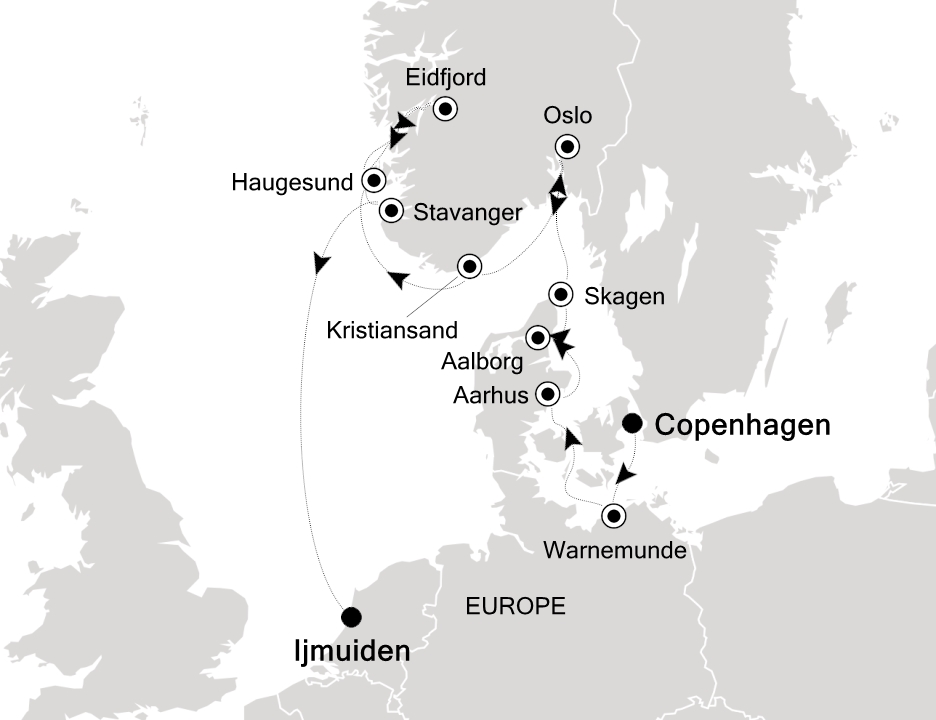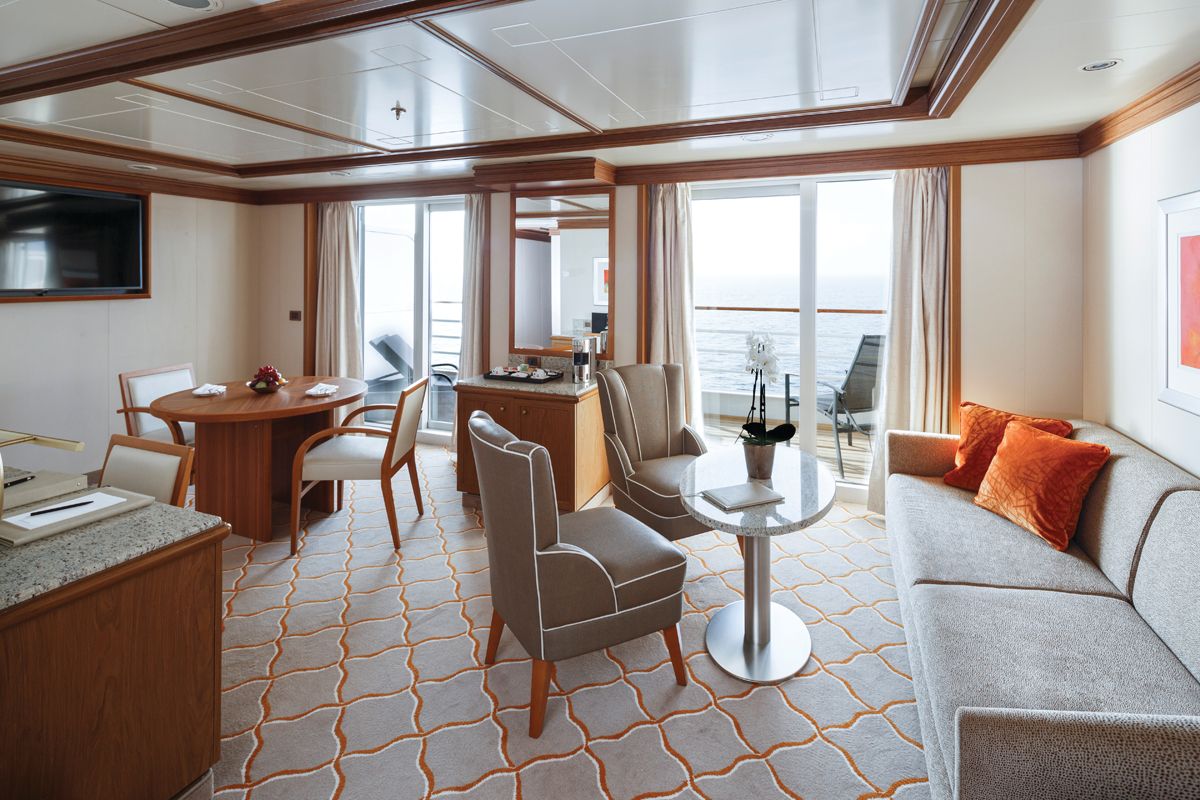

Go beyond your boundaries and explore the world as never before.
The Kingdom of Denmark is the geographical link between Scandinavia and Europe. Half-timber villages and tidy farms rub shoulders with towns and a few cities, where pedestrians set the pace, not traffic. In the capital, Copenhagen—København in Danish—mothers safely park baby carriages outside bakeries while outdoor cafés fill with cappuccino-sippers, and good looking Danes pedal to work in lanes thick with bicycle traffic. The town was a fishing colony until 1157, when Valdemar the Great gave it to Bishop Absalon, who built a castle on the site of what is now the parliament, Christiansborg. It grew as a center on the Baltic trade route and became known as købmændenes havn (merchants' harbor) and eventually København.
In the 15th century it became the royal residence and the capital of Norway and Sweden. From 1596 to 1648 Christian IV, a Renaissance king obsessed with fine architecture, began a building boom that crowned the city with towers and castles, many of which still stand. They're almost all that remain of the city's 800-year history; much of Copenhagen was destroyed by two major fires in the 18th century and by British bombing during the Napoleonic Wars.
Today’s Copenhagen has no glittering skylines and little of the high-stress bustle of most capitals. The morning air in the pedestrian streets of the city's core is redolent of baked bread and soap-scrubbed storefronts. If there's such a thing as a cozy city, this is it.
Warnemünde, officially a suburb of Rostock, is a quaint seaside resort town with the best hotels and restaurants in the area, as well as 20 km (12 miles) of beautiful white-sand beach. It's been a popular summer getaway for families in eastern Germany for years.
There is little to do in Warnemünde except relax, and the town excels brilliantly at that. However, Warnemünde is a major cruise-ship terminal. Whenever there is more than one ship at dock, the town explodes with a county fair–like atmosphere, and shops and restaurants stay open until the ships leave at midnight. The city celebrates the dreifache Anlauf, when three ships dock simultaneously, with fireworks.
Århus is Denmark's second-largest city, and, with its funky arts and college community, one of the country's most pleasant. Cutting through the center of town is a canal called the Århus Å (Århus Creek). It used to run underground, but was uncovered a few years ago. Since then, an amalgam of bars, cafés, and restaurants has sprouted along its banks. At all hours of the day and night this waterfront strip is abuzz with crowds that hang out on the outdoor terraces and steps that lead down to the creek.
The VisitÅrhus tourist office has information about the Århus Passport, which includes passage on buses, free or discounted admission to the 12 most popular museums and sites in the city, and tours.
For more than a century, Skagen (pronounced skane), a picturesque area where the North Sea meets the Baltic Sea, has been a favorite destination of well-off travelers, artists, and architects. This 600-year-old market town on Jutland's windswept northern tip has long pebbly beaches and huge open skies. Sunsets are tremendous events, so much so that idlers on the beach stop and applaud. Its main industry has traditionally been fishing, but tourism now seems to be eclipsing that.
What sets Oslo apart from other European cities is not so much its cultural traditions or its internationally renowned museums as its simply stunning natural beauty. How many world capitals have subway service to the forest, or lakes and hiking trails within city limits? But Norwegians will be quick to remind you that Oslo is a cosmopolitan metropolis with prosperous businesses and a thriving nightlife.
Once overlooked by travelers to Scandinavia, Oslo is now a major tourist destination and the gateway to what many believe is Scandinavia's most scenic country. That's just one more change for this town of 650,000—a place that has become good at survival and rebirth throughout its 1,000-year history. In 1348 a plague wiped out half the city's population. In 1624 a fire burned almost the whole of Oslo to the ground. It was redesigned and renamed Christiania by Denmark's royal builder, King Christian IV. After that it slowly gained prominence as the largest and most economically significant city in Norway.
During the mid-19th century, Norway and Sweden were ruled as one kingdom, under Karl Johan. It was then that the grand main street that's his namesake was built, and Karl Johans Gate has been at the center of city life ever since. In 1905 the country separated from Sweden, and in 1925 an act of Parliament finally changed the city's name back to Oslo. Today, Oslo is Norway's political, economic, industrial, and cultural capital.
What sets Oslo apart from other European cities is not so much its cultural traditions or its internationally renowned museums as its simply stunning natural beauty. How many world capitals have subway service to the forest, or lakes and hiking trails within city limits? But Norwegians will be quick to remind you that Oslo is a cosmopolitan metropolis with prosperous businesses and a thriving nightlife.
Once overlooked by travelers to Scandinavia, Oslo is now a major tourist destination and the gateway to what many believe is Scandinavia's most scenic country. That's just one more change for this town of 650,000—a place that has become good at survival and rebirth throughout its 1,000-year history. In 1348 a plague wiped out half the city's population. In 1624 a fire burned almost the whole of Oslo to the ground. It was redesigned and renamed Christiania by Denmark's royal builder, King Christian IV. After that it slowly gained prominence as the largest and most economically significant city in Norway.
During the mid-19th century, Norway and Sweden were ruled as one kingdom, under Karl Johan. It was then that the grand main street that's his namesake was built, and Karl Johans Gate has been at the center of city life ever since. In 1905 the country separated from Sweden, and in 1925 an act of Parliament finally changed the city's name back to Oslo. Today, Oslo is Norway's political, economic, industrial, and cultural capital.
Stavanger has always prospered from the riches of the sea. During the 19th century, huge harvests of brisling (also called sprat) and herring helped put it on the map as the sardine capital of the world. Some people claim the locals are called Siddis, from S(tavanger) plus iddis, which means "sardine label," although some linguists argue it's actually a mispronunciation of the English word "citizen."
During the past three decades a different product from the sea has been Stavanger's lifeblood—oil. Since its discovery in the late 1960s, North Sea oil hasn't just transformed the economy; Stavanger has emerged as cosmopolitan and vibrant, more bustling than other cities with a population of only 110,000. Norway's most international city, it has attracted residents from more than 90 nations. Roam its cobblestone streets or wander the harbor front and you're likely to see many cafés, fine restaurants, and lively pubs, as well as many museums, galleries, and other venues that are part of its rich, dynamic art scene.
World Cruise Finder's suites are some of the most spacious in luxury cruising.
Request a Quote - guests who book early are rewarded with the best fares and ability to select their desired suite.












